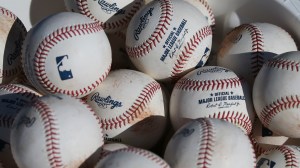UNIVERSITY PARK, Pa. (WTAJ) – In mid-March, staff in the Penn State research department started the “Manufacturing and Sterilization for COVID-19” initiative, or “MASC”, to give medical professionals the tools and defense they need to help beat COVID-19.
“We had a grassroots effort of talking about how can we address the PPE shortage, personal protective equipment, healthcare workers and else wise,” Tim Simpson, Professor of Mechanical and Industrial Engineering at Penn State said. Simpson continued, “Sort of had an email exchange with folks that continued to grow.”
Now over 350 people from Penn State are working on the initiative. Help comes from students and staff in the Arts and Architecture departments making an isolation booth to theater students and staff sewing masks and gowns, for health care workers.
The “PPE”, personal protective equipment initiative workers have made has gone to Penn State Hershey, to Mount Nittany Medical Center, Juniper Village Senior Living Facility in State College and to the State College Borough and Police Department.
Folks from Penn State with the initiative contacted local manufacturers, like Actuated Medical in Bellefonte, to see what they would be able to make that hospitals are in need of.
“One of the ideas that came through was face shields, we need more face shields and so Actuated Medical said we can do that, and so we spun out our own face shields manufacturing line,” Maureen Mulvihill, President and CEO, Actuated Medical, said.

Actuated Medical got this assembly an assembly line and running in one week, a process that typically takes two or three weeks. In the past six weeks, they’ve sold over 7,000 face shields.
It’s not just healthcare workers benefitting from the face shields. Half of the face shields bought have been donated to first responders like Bellefonte EMS or assisted living facilities like Juniper Village.
“With this plastic barrier, this is in front of your face, one you’re not touching your face, you’re not worried about giving yourself the contracted illness, but also, the idea is if somebody coughs, you’re protected, it’s not going to go into your eyes, it’s not going to go into your nose,” Mulvihill, said.
In Phillipsburg, Drew Nissly combined his knowledge from his welding designing tools business with Clay Passarelli’s expertise from his orthopedic manufacturing design company, to form Pure Respirator LLC.
Passarelli says he learned there was a need for “PAPRs” or powered air-purifying respirators.
“I have a lot of friends in the medical field, surgeons, anesthesiologists, nurses and I actually contacted them to find out whether or not they were being provided, higher-level protection, which in most cases, it wasn’t available., Passarelli, said.

People from the Penn State initiative helped Nissly and Passarelli with the design of the respirator.
Passarelli says the respirator has an air pump that forces air from the unit to a tube, to the headgear.
“The basic principle of a PAPR is to supply purified air to the user, it does that in the manner of using filter media to pull air into a sealed enclosure,”
Clay Passarelli
This keeps a person from breathing in air that potentially has coronavirus particles in it.
Back at Penn State, Jose Duarte, Director at Stuckeman Center for Design and Computing at Penn State, and a team of students and Architecture and Engineering staff made an “Isolation Booth”.
“The nurse that is inside sticks her arms into these gloves and then tests the patient and after the test, they put their hands inside the whole. There is a paddle at the bottom, that activates a sprayer, that sanitizes the gloves., Duarte, said.


He says the booth not only protects the doctor while performing a temperature test or swab test on a potential COVID-19 patient, but it will also help the PPE shortage problem.
“By using the booth we are able to save goggles, masks, and gloves because you don’t need to use as many because it’s used all the time,” Duarte, said.
The team has made one booth, which costs three thousand dollars. Once their revisions get final approval from Penn State doctors, volunteers will order parts to make twelve more isolation booths to send to Penn State Hershey, Mount Nittany Medical Center, and other facilities.
“You can produce a couple of booths in the same day, which is a very huge potential in terms of ramping up the screening efforts,” said Naveen Kumar Muthumanickam, Architecture Graduate Student, Penn State
The initiative team has raised over one hundred and twenty thousand dollars from different various departments and colleges, to pay for equipment supplies and man-hours.
“A lot of energy and a lot of passion there and being able to channel that and direct it to help healthcare workers and fight off the viruses, it’s a good thing,” Simpson, said.
The next piece of medical equipment Penn State students and staff are working on bringing doctors is disposable stethoscopes.
Simpson says there’s a shortage of stethoscopes, from doctors using them, throwing them away, and not thinking about the shortage.
To help Penn State’s initiative you can go to:
https://masc.psu.edu


